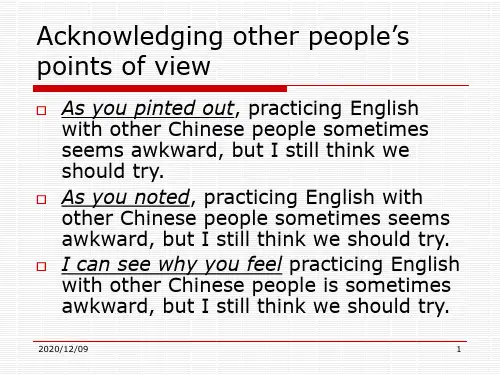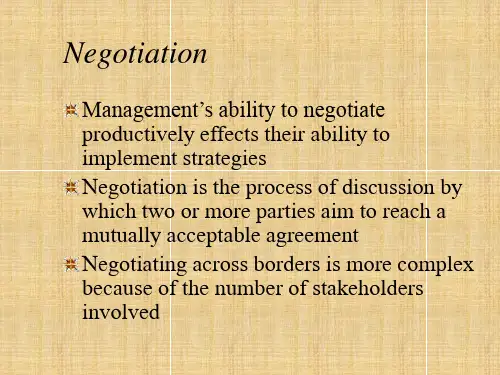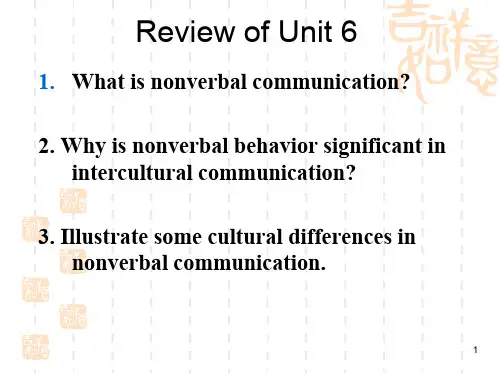- 1、下载文档前请自行甄别文档内容的完整性,平台不提供额外的编辑、内容补充、找答案等附加服务。
- 2、"仅部分预览"的文档,不可在线预览部分如存在完整性等问题,可反馈申请退款(可完整预览的文档不适用该条件!)。
- 3、如文档侵犯您的权益,请联系客服反馈,我们会尽快为您处理(人工客服工作时间:9:00-18:30)。
Components of nonverbal communication
Body language: gestures, postures, eye contact, direction of gaze, nod, head movements, facial expression, general appearance and dress/ clothes, bodily, adornment orientation Spatial language/Proximity: body distance , body touch, personal space, seating, furniture arrangement Temporal language: monochromic time and polychronic time Paralanguage: voice modulation, silence
Mini-case
In class a British professor leaned back in his chair, put his feet up on the desk, and went on with the explanation. The class was furious. Before the end of the day, a demonstration by the University’s full student body had taken place. Petitions were submitted to the deans of the various facilities. They denounced British arrogance and demanded that the professor be sent home. The next day, the situation even made the newspaper headlines. Yet, to the native, the students’ behavior was logical and in context. The students and their supporters were outraged because of the implications of the breach of the native behavioral pattern. In the Middle East, it is extremely insulting to have to sit facing two soles of the shoes of somebody.
the cultural variations in eye contact
Facial Expressions
six basic emotions: surprise, fear, disgust, anger, happiness, and sadness. Shock, honor, revulsion, fury, ecstasy and grief are strongly felt variants of each of these. Combinations of the six basic emotions give rise to others, such as embarrassment, shame, pride, shyness, boredom, suspicion, and confusion.
Body posture
The Japanese value the ability to sit quietly. People in different countries walk and carry themselves differently. Informal postures of Americans and Australians Squatting posture of Chinese farmers
Australia Estonia France China Ireland India Middle East countries
Touch
Japan United States Canada Scandinavia Other Northern European countries
Latin American countries Italy Greece Spain and Portugal Some Asian Countries Russia
Laughing and Smiling
The Chinese laughing The Japanese smiling
Spatial language / proxemics
Body Distance
Short distance: Latins, Mediterranean Arabs, Mediterranean Europeans medium distance: Americans, Northern Europeans long distance : Japanese
The single finger beckon.
Eye contact
“rules” about eye contact: to look or not to look; when to look and how long to look; who and who not to look at, etc. All cultures have their unique social rules governing their eye contact. What would you do according to Chinese custom? You can choose more than one answer from the given choice.
Use of space in the office
Location of office to indicate rank. Difference in office arrangement Ma culture in Japan (Ma=space) Furniture Arrangement Seating
Thumbs up Approval: U.S.;Britain; Russia Highly offensive:Iran Rude: Australia Thumbs down Disapproval: U.S.;Canada Rude: Greece
Gestures Around the World
cultures in non-verbal communication are a major source of friction, misunderstanding, and annoyance in ICC. Nonverbal communication is also rooted in culture.
Temporal Language
Leabharlann Monochronic (M-time): the United States, Germany, and Switzerland Polychronic time (P-time) : Punctuality and promptness Time frame Informal time (Text. p.167) Past, Present, Future
Closed Fist Obscene Gesture: Pakistan Obscene: Lebanon The V Sigh Victory: Britain;U.S. Peace: U.S
Gestures Around the World
To Hell with You Offensive Gesture: Britain; South Africa The Finger Highly Offensive: U.S.;Most of Europe; Many parts of world
Talk 6
Culture’s Impact on Non-verbal Language
Non-verbal communication
Communication theorists assert: less than 30% of communication is verbal in nature. Over 70% of communications takes place nonverbally. Edward Hall : “Silent Language” in 1959, laid the foundation for the study of non-verbal communication.
Body Language
Eisenberg asserts that body language vocabulary totals over 270,000 items. Samovar declares that it comes to 700,000. The Webster’s Third New International Dictionary records no more than half a million words
Functions of non-verbal communication
Replacing Modifying Regulating Conveying
![跨文化交际(UNIT 7)[优质ppt]](https://uimg.taocdn.com/45189eb60912a21615792900.webp)









